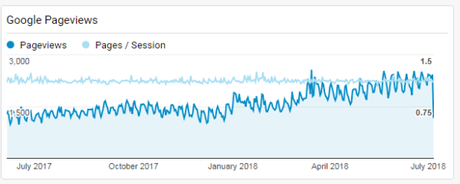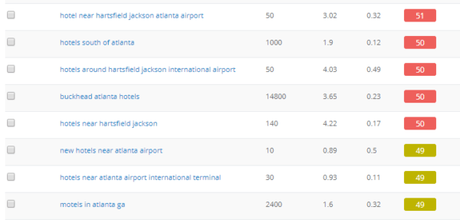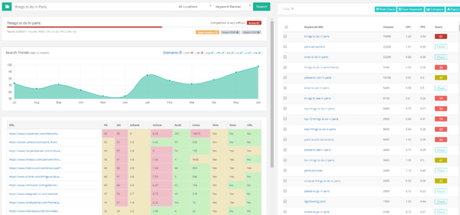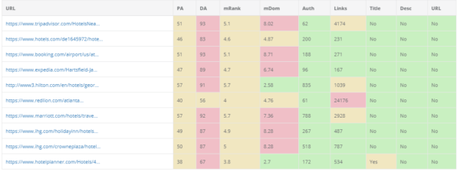Disclaimer: Living the Dream uses demographic data, email opt-ins, display advertising, and affiliate links to operate this site. Please review our Terms and Conditions for more information and our Privacy Policy.
Keysearch is a premium keyword research tool that really has changed our lives since getting a subscription.
The reason for this is simple, because Keysearch goes beyond telling you keyword volumes and also tries to tell you the likelihood you would rank for any given keyword.
So don't keep throwing keywords at your site and hope they stick, take a targeted approach with this service.
Dive down more into this full review to find out more!
How Keysearch Works and Why Its Different

On the surface, Keysearch is a simple tool that shows you the search volume of any given keyword in Google. Type a keyword in, hit enter, and get your results.
Sounds easy, right?Well, you could do just this and enjoy the service just fine, but there is so much more data offered by Keysearch when you dig a little deeper (and even in this review, we're just scratching the surface).

In fact, Keysearch is quite powerful as not only does the service tell you how many searches per month a keyword gets, but it also tells you the search volumes of comparable keywords, the difficulty it is to rank for each, and how strong the websites are that currently rank for the terms.
It is only when looking at all of this data from a holistic point of view can you figure out if you may be able to rank for your site, and Keysearch tries to capture this via a keyword score to highlight the difficulty in ranking for any given keyword on a 0-100 point scale.
Find a keyword with high traffic and a low score? You've hit gold! Find one that is too high? Move on before you waste your time.

But as this keyword is just an arbitrary metric of difficulty, we want to walk you through our thought process for how we interpret the data from Keysearch.
How We Look at Keysearch Data

Now, it would be easy to simply look at the Keysearch keyword score, compare it to your site's DA and use that as the determining factor and move on.
In fact, it is actually a fairly solid analog in our opinion- ignoring the fact that both numbers are completely arbitrary.
Keysearch doesn't explicitly call this out as something you should do, but we've generally seen a correlation to their score to the minimum DA ranked in the top 10. If you have a DA of 20, odds are good you're not going to rank for terms much higher than Keysearch score of 20. If you have a DA of 55, you can probably compete with scores in the 50s, and so on.
But we have to caution using just this number, because Keysearch provides even more data you need to keep in mind when reviewing keywords.
When reviewing Keysearch results, we personally do the following for our sites of DA 39 (this one) and DA 29 (our niche local blog):
- Pick a keyword, search, and filter out keyword volumes > 1,000 monthly searches (> 5,000 if a lot of high volume and relevant keywords are available).
- Look at the scores of keywords that have high traffic and are relevant.
- Take a deeper look at the lower scores that you could compete with (we look at up to 40 on our global blog and 50 on our niche local blog*)
- Look at the competition in the Top 10 and check out their DA, backlinks, and keyword usage to determine overall competition.

If we've found a keyword with a high search volume, a low Keysearch score, and a few links in the top 10 with a DA lower than ours, we think we have a fairly good chance at cracking the top 10- especially if no article uses the keyword in the title, description, and URL (SEO signals explicitly called out by Keysearch).
If we've found a keyword with a high search volume, a low Keysearch score, and no links in the top 10 with a DA lower than ours, we move on. Even though Keysearch gives it a lower score, it may be an uphill battle to compete with the sites in the Top 10 and we move on (unless there are extenuating circumstances that push us to proceed).
From there, we implement using standard SEO best practices via incorporating the keyword into the article title, slug, meta description, header tags, etc. and wait for the next update to see if we get a bump.
Now, it would be easy for us to wrap up this article here in how we use this approach in finding keywords with Keysearch, but we want to take this one step further and go into the three ways we've used the program to optimize our SEO as how you apply the data is just as important as understanding the data in the first place!
*You may notice we target higher scores on our niche blog even with a lower DA when compared to our global blog. This is due to lower competition overall such that our site ranks quite well even with a lower authority (it is still relatively young and hasn't had a time to catch up in DA). You should have a feel for how your site performs against competition when thinking through this service, but unless you already dominate in your niche odds are good you won't have this exception.
#1 - Gaining Higher Placement for Existing Keywords
The first way we've looked at Keysearch data is to find articles that we already rank in the Top 10 for.
We look at all of the relevant keywords brought up by Keysearch and compare our current rank to the search volumes of each term.
In many cases, we've found variants of specific terms that have higher search volumes or easier scores than the one we targeted, and by making minor modifications into these posts (again, via best practices), we were able to push our rankings for key articles with minimal effort.
I'll gladly take ranking #2 over #7 for any keyword, and you should too!#2 - Finding New Keywords for Non-Ranking Posts
The second way we've looked at Keysearch data is to try and index articles that have previously not ranked in Google.
These are articles that do well on social media, but for whatever reason get little to no impressions or traffic in Google. As far as the search behemoth is concerned, they're dead and need reviving.
Here we look for similar keywords to the ones we were targeting, because very clearly our organic keyword generation did not work (they were either too competitive or had no traffic).
So we look at similar keywords as suggested by Keysearch, find one with a low score and higher search volume, implement, and wait for indexing.
I'll gladly take ranking on #7 for any keyword over not ranking on the first page at all!- Pro-Tip - Use the Explorer feature that was introduced in 2018 to get a great snapshot of all the keywords. Organize them in Excel and then check their keyword difficulty to see if you can find any quick wins for other high volume keywords you may not use but still rank on Page 2, 3, 4 etc. A jump may be easy!
#3 - Overhauling Our Affiliate Game to Earn Money
The third way we've looked at Keysearch data is to try and find keywords that are being used by people who are looking to shop.
These are for articles that may or may not do well in Google already, but are overall trying to push an affiliate product in some way, shape, or form.
In this particular instance the keyword is being selected not just for its ease of being indexed, but by targeting the right reader - the one who is wanting to purchase.
Inserting yourself in this part of the sales funnel is key because, depending on your industry, it could be a long way from research to purchase. So tailoring your articles for keywords targeting those who want to purchase is critical.
There is no one-size-fits-all approach to this one, but we look for keywords with active terms (book, buy, etc) or for when people are looking for dedicated product reviews. Its not foolproof, but it is a step in the right direction. 500 or 1,000 monthly searches of people looking to buy could end up earning significantly more than on a keyword with 10,000 people just looking for reviews or advice!
I'll gladly downsize my search volume to rank for a keyword that converts!Overall, there are many ways you can implement Keysearch data on your blog and come out ahead. The possibilities are near endless and even we are just starting to scratch the surface with some of the cases outlined above.
But we've found one major thing to be true overall- the more we dive into Keysearch data and truly begin to understand how it all works, the better our content becomes, and the better rank we get in search placements.
For that, it is worth every penny many times over.Get 20% off Keysearch with our discount code: KSDISC Click here to purchase your license to Keysearch today!
Share This Article on Social Media!
Start a Blog Today
Thinking of starting a travel blog? Click the previous link to read our ultimate guide for success! Once you're ready, grab a domain at Bluehost and get started in just a few steps!
Grab a Server

Buy a Theme

Be The Expert

Then, when you're ready, check out our favorite Wordpress plugins, sign up for premium services like Tailwind or Mailerlite, and get started on owning your niche.
